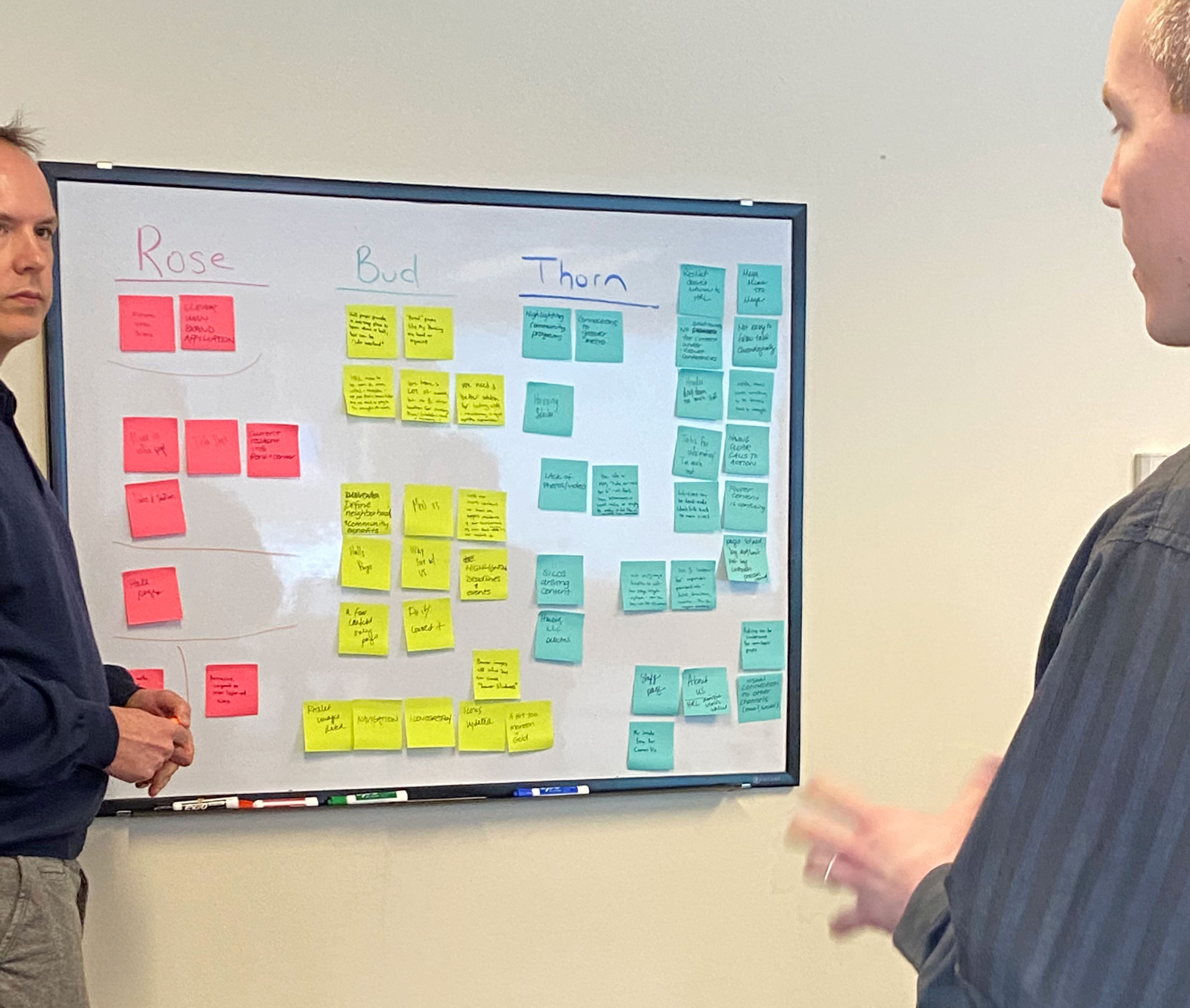Plan for User Testing
Every website is designed with at least one major goal and outcome in mind.
These include getting people to register for an event, make a donation, sign up for a newsletter, provide resources and help, and so on. But even the best planned and best executed website can fail to deliver.
People may get lost as they search and navigate, missing the paths we want them to take. Others simply don’t understand what they’re supposed to do. If they can’t find what they’re looking for, they’ll quickly leave without taking any action.
With all the time and effort put toward a modern website, and the many years we’ve spent building them, how can this happen?

Every website is built on assumptions. No matter how experienced and well researched a website may be, there’s always some reliance on what we assume to be the right decisions. It can be a well-reasoned and logical assumption, based on audience research, interviews, analytics, surveys and past success. But there’s still an element of uncertainty. Why? Because… humans.
People are unpredictable and prone to misunderstandings or mistakes. This is true of both people building the sites and the people using them. The truth is, no one really knows how a user will interact with a website until they actually do it. At that point, however, who’s still paying attention to what works and what doesn’t? By the time a website is launched, the site building team may have moved on, the budget spent, and the site owners and editors back to their daily lives.
We have analytics to help alert us to where users are going. But they don’t tell us the whole picture. They don’t tell us the “why.”
How can we move beyond assumptions, and learn the real reasons users do what they do? The solution is simple– start budgeting time for user testing. We need to understand if our websites are as effective as we designed them to be.
We have analytics to help alert us to where users are going. But they don’t tell us the whole picture. They don’t tell us the why.
When you hear the term “user testing,” you may think of a fancy lab-like setting, with researchers hidden behind two-way mirrors, wires strapped to the heads of subjects, scientists wearing white lab coats asking questions, and cameras following your every move. Or you may not, that’s just an image that comes into my head! I do consume a lot of science fiction.
But it’s usually nothing that complicated or strange. While very nice and professional users testing labs can have their place, user testing is often cheap and easy to set up and run while still being very effective! Let me briefly break down the process.
Step 1: Get a facilitator
To begin with, you want to hire an experienced facilitator to lead your testing efforts. This can be through an agency like Electric Citizen, or perhaps you have a UX professional within your organization. You need a guide in organizing the process, running the tests, and analyzing the results.
Step 2: Decide what to test
It shouldn’t be “all the things.” A successful test is focused on a particular goal or outcome important to your organization. For example, you may wish to confirm if changes to your site navigation will make it easier for your audience to find what they’re looking for. Or you might want to confirm that users understand the steps they’re supposed to take to complete a goal online.
Work with your facilitator to first set your testing goal. Successful user testing should be limited in scope. You can have a number of questions to ask users, but they should all be centered around one particular topic. The more focused the test, the better the outcomes. You don’t want to try and make sense of too much data at once or plan an overly long and exhausting testing process. If you have many goals, that’s okay–just plan on running more than one set of tests over a longer period of time.
Step 3: Write the script

Now that you know what to test, you need to write the testing script. These should be a short series of questions or scenarios that you ask your test subjects to complete.
For example, on a city government website, you may ask users how to find out about upcoming construction projects in your neighborhood. On a higher ed website, you may ask users how to find a particular major or housing. A nonprofit may want to see if users can find a particular service or way to donate.
Whatever it is you're testing, work with your facilitator to draft a list of questions. It shouldn't be too long. 30 minutes is plenty of time to run through 5-8 questions and gain insights without asking too much of your test subjects. Keep your questions short and focused, and try to avoid leading questions that give users too much guidance as to what you expect.
Step 4: Recruit the right people
Once you have your script, you need to find your test subjects. Where are you going to find the volunteers you need for your user testing? There are two main options here–recruiting them yourself or paying someone else to do the work for you.
I’ve found a lot of success in letting our clients find their own test subjects among their constituents. Not employees, but the people who use their services. Most organizations have a good sense of who the audience is they're trying to reach, and a means to contact them as volunteers. Another option is to post a story or callout on your website about user testing, with an ask for volunteers.
If that doesn’t work, there are paid services that will find testers for you. It won’t necessarily be as close to your organization as your own known customers, but it will help get you started. I don’t have any direct recommendations here, you’ll just have to rely on search or word of mouth to go that route.
Wherever your testers come from, you should consider giving out a small reward to each tester for their time. This will help with recruiting efforts and show your appreciation for their time.
Step 5: Test!
With all these elements in place, you are ready to conduct your user testing! User testing can be done in person or remotely. Your facilitator will meet with each tester, run through the testing script and make observations of each user. Looking for patterns and other findings, your facilitator will use the test results to come with a list of recommendations for change.
No matter how well executed the original plan may be, user testing will almost always turn up some new information and insights towards making your website better.
Steps 6+: Remaining Steps
Steps 6 and 7 involve analyzing your findings and determining what changes are needed. And step 8 is “repeat as needed” til you get the improvements you are wanting. And that’s it! With the right people, it's not so hard to get testing in a short amount of time.

If you’re planning a new website or redesign, you should be working with a long term schedule and process. This typically begins with planning and discovery, then moves to design and development, content editing and/or migration, QA and training, and then finally a launch. So where in this process does user testing fit in?
In my experience, there isn’t only one time in the project to test–there’s opportunities throughout the project. How often is really up to your own needs (and time/budget available to spend).
At the start of a project (with existing sites), you could begin by testing how the current site is performing. You may already have enough data to begin with changes, but sometimes it’s just assumptions. How well do your users reach your goals today?
Many projects have some evidence that the user experience could be improved, starting with an easier-to-use and easier-to-understand site navigation. Changes to the sitemap are made. But are these effective changes? This is another obvious testing point. Before we go too far with restructuring our navigation and content, run some user tests with the new navigation and see if users can find what you’d like them to read or follow the path you envisioned.
As you work through new designs and mockups, there’s another opportunity to test. You could put static mockups in front of users and ask them to point to where on the page they’d go to complete a task. You could test if moving a page element higher on the page increases visibility and understanding. Assuming your design changes involve new content, new layouts, and other new elements, this is a chance to test user comprehension before putting those changes to code.
Once you’ve moved to web development and putting your new site into action, you can start scheduling user testing with actual functioning web pages. Assuming you are able to put up a “beta” version of the site or some other test environment, you could start testing new features and functionality before the site goes live. This gives you time to get feedback and make any necessary adjustments before launch.

All the previous scenarios assumed you were involved in a new build or redesign. But even if you already launched your site, it’s not too late to benefit from testing!
With a live site, you’ll have had time to make a number of observations about its effectiveness–sales, donations, registrations, traffic, bounce rates, etc. But like stated earlier, that’s not necessarily the full picture.
For example, if analytics show people are spending a short amount of time on the site, is that bad? Maybe they’re leaving because they don’t find what they are looking for. It’s also possible they're quickly finding information and leaving for other reasons (good or bad).
The point is, you don’t really know until you run some tests and have some conversations with users.
Start by generating an update list of your primary goals or desired outcomes for the site. Prioritize your list based on what areas seem most important today and/or seem to have been underperforming the most. These will form the basis for your next round (or first round) of user testing! Schedule time with your team and external partners (if applicable), and follow the process listed above to start testing.
So many things can change over time–your content, your user base, the devices and methods of interaction, the economy, pandemics, etc. Making user testing a regular, recurring process, even after launch, is just another way to keep improving your product, better serving your audience and increasing conversions.
Just like regular exercise, user testing will keep your website fit and healthy.
Conducting periodic user testing doesn’t have to be a large expense. Just make it part of your annual plans, and work with your team to budget the hours for it ahead of time.
At Electric Citizen, clients with support contracts can set aside unused support hours toward user testing. The process will help inform where future site improvements are best targeted.
Contact us to learn more about scheduling user testing for your website.




Join the Discussion +